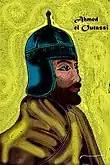| Abu al-Abbas Ahmad | |||||
|---|---|---|---|---|---|
 | |||||
| Sultan of Morocco | |||||
| Reign | 1547 – 1549 | ||||
| Predecessor | Nasir al-Qasri | ||||
| Successor | Ali Abu Hassun (regent of the crown) | ||||
| Sultan of Morocco | |||||
| Reign | 1526 – 1545 | ||||
| Predecessor | Abu Abd Allah al-Burtuqali Muhammad ibn Muhammad | ||||
| Successor | Nasir al-Qasri | ||||
| Born | Unknown | ||||
| Died | 1549 | ||||
| Spouse | Sayyida al Hurra | ||||
| Issue | Nasir al-Qasiri Lalla Halou[1] | ||||
| |||||
| Dynasty | Banū Wattās | ||||
| Father | Abu Abd Allah al-Burtuqali Muhammad ibn Muhammad | ||||
Abu al-Abbas Ahmad ibn Muhammad (Arabic: أحمد بن محمد بن محمد الوطاسي), also Sultan Ahmad, or Ahmad al-Wattasi, was a Sultan of the Moroccan Wattasid dynasty. He ruled from 1526 to 1545, and again between 1547 and 1549.[2]
Life
In 1532, Ahmad ibn Muhammad sent a letter to Francis I of France through trader Hémon de Molon, encouraging the French king to develop trade relations.[3] In 1533, Francis I of France sent as ambassador to Ahmad ibn Muhammad, in the person of colonel Pierre de Piton.[4] The embassy was made up of five gentlemen and the pseudo-merchant Aymond de Molon were part of the expedition: the embassy carried watches, mirrors, combs and other "merceryes" with some falconry items; everything was to be offered to Ahmed ibn Muhammad, the King of Fez, and to his vizier and brother-in-law Moulay Ibrahim ben Ali ibn Rashid al-Alami. The embassy landed at Larache and was conducted to the king's mahalla, which was in the vicinity; the ambassador handed over the presents, which were little tasted, then he accompanied the king to Fez, staying a month there.[5][6]
Following this embassy, in a letter to Francis I dated August 13, 1533, Ahmad ibn Muhammad welcomed French overtures and granted freedom of shipping and protection of French traders.[7] His foreign policy being to counter the fast-growing powers of Spain and Portugal who keep holding fortress enclaves on Moroccan soil.
In 1545, Sultan Ahmad was taken prisoner by his southern rivals the Saadians.[8] His successor, Ali Abu Hassun, regent for Ahmad's young son Nasir al-Qasiri, decided to pledge allegiance to the Ottomans in order to obtain their support.[8]
France actually started to send ships to Morocco in 1555, under the rule of Henry II, son of Francis I.[7]
He married Sayyida al Hurra.
Notes
- ↑ "Lala Halou bint Ahmad ben Mohammed Al-Wattasia Princesse Wattasides". geni_family_tree. Retrieved 2022-04-06.
- ↑ C. E. Bosworth, The New Islamic Dynasties: A Chronological and Genealogical Manual, Edinburgh University Press (2004), pp. 48–49 ISBN 9780748621378
- ↑ "THE EMBASSY OF PIERRE DE PITON: In the year 1533, the year of Montaigne's birth, a French merchant, from Bresse, Hemon de Molon, returned from Morocco, filled with such enthusiasm that Francis I decided to find out more" in Ecrits de Paris: revue de questions actuelles Centre d'études des questions actuelles, politiques, économiques et sociales (Paris, France) - 1953 (in English)
- ↑ "Francois I, hoping that Morocco would open up to France as easily as Mexico had to Spain, sent a commission, half commercial and half diplomatic, which he confided to one Pierre de Piton. The story of his mission is not without interest" in The conquest of Morocco by Cecil Vivian Usborne, S. Paul & co. ltd., 1936, p.33
- ↑ Castries, Henry de La Croix (1850-1927 ; comte de) Auteur du texte (1911). Agents et voyageurs français au Maroc, 1530-1660 / Cte Henry de Castries (in French). pp. II.
{{cite book}}: CS1 maint: multiple names: authors list (link) CS1 maint: numeric names: authors list (link) - ↑ "Malika VI: Sayyida Al-Hurra - AramcoWorld". www.aramcoworld.com. Retrieved 2022-04-06.
- 1 2 Travels in Morocco, Volume 2 James Richardson p.32
- 1 2 A history of the Maghrib in the Islamic period by Jamil M. Abun-Nasr p.155ff